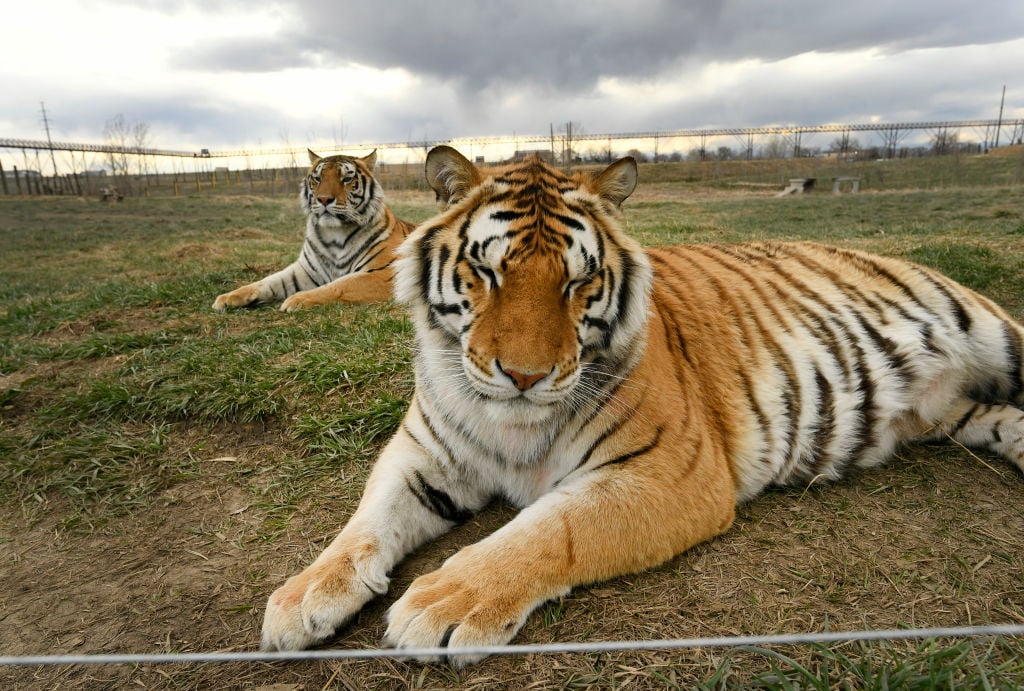‘Tiger King’: Where Are All the Tigers From the G.W. Zoo Now?
The Netflix docuseries Tiger King: Murder, Mayhem and Madness captured the cruel treatment of tigers and other exotic animals at the Greater Wynnewood Exotic Animal Park (also known as the G.W. Zoo) in Oklahoma.
The former owner of the zoo, Joseph Maldonado-Passage, better known as Joe Exotic, was sentenced to 22 years in prison for animal abuse and an elaborate murder-for-hire plot.
Fortunately, many of the tigers and bears featured from the docuseries were rescued by the Wild Animal Sanctuary in Keenesburg, Colorado.

Saving wildlife from Joe Exotic’s zoo
Becca Miceli, the Chief Science and Animal Welfare Officer at the Wild Animal Sanctuary, explained the process of rescuing the tigers to a CBS affiliate in Denver. “In 2017, we went on two different rescues to help get a total of 39 tigers and three black bears out of the facility,” Miceli said.
Miceli explained that many of the animals rescued from the G.W. Zoo had orthopedic issues as a result of poor nutrition. “They ranged in different conditions, I think the biggest thing is that they were all exploited to some degree,” Miceli said, then elaborated: “Whether it be for entertainment watching, a person play with them, for people to take selfies with.”
In the documentary series, Maldonado-Passage had trouble affording enough food to feed all of the tigers he held in captivity. He also allowed the G.W. Zoo guests to pay to play with tiger cubs.
The difference between the Colorado sanctuary and the G.W. Zoo
Kent Drotar, the public relations director for the Wild Animal Sanctuary told People how their organization is “almost the complete anthesis to what those other places [like the G.W. Zoo] do.” Unlike the private zoos depicted in Tiger King, the Colorado rescue “give[s] permanent homes to animals that come from situations like that,” Drotar explained.
The Wild Animal Sanctuary operates as a non-profit and consists of two properties. The Wild Animal Sanctuary is where illegally bred and kept animals are taken upon rescue, and the Wild Animal Refuge, which is as an extra 10,000-acres that provides more space for the sanctuary’s rescues.
Unlike the G.W. Zoo, the Wild Animal Sanctuary and the Wild Animal Refuge do not breed animals, nor do they allow guests to have hands-on contact.
The Wild Animal Sanctuary in Colorado
The Wild Animal Sanctuary has rescued more than 1,000 animals in its 40-year history, with more than 520 lions, tigers, bears, wolves, and other rescued animals as listed on their website.
Drotar explained that 80% of the animals at the sanctuary come to them after being confiscated by law enforcement. He told People the animals often come by way of the United States Department of Agriculture (USDA) or U.S. Fish and Wildlife, who seize abused or illegally-owned wild animals. The Wild Animal Sanctuary serves as a safe place for those animals to live once legal proceedings connected to their seizure are complete.
Drotar said Maldonado-Passage’s tigers and bears came to the sanctuary “through a mix of surrender and the threat of legal action.” After attempting to confuse law enforcement by moving 19 tigers from the G.W. Zoo to another privately owned zoo in Dade City, Florida, People for the Ethical Treatment of Animals (PETA) filed a lawsuit against the Florida zoo for allowing cub petting.
To avoid the legal trouble Maldonado-Passage was threatened with as a result of his actions, he agreed to give up the tigers and bears to the Wild Animal Sanctuary. Drotar said Maldonado-Passage’s decision came just after his husband Travis Maldonado died.
While Maldonado-Passage sits in prison, his tigers are living a better life. Drotar reported that the animals rescued from the “Tiger King’s” zoo are happier now. “It was almost an immediate change [in] their demeanor,” Drotar said, adding: “They see other tigers. They see other animals. They see a horizon. They just have more of a purpose for living.”


